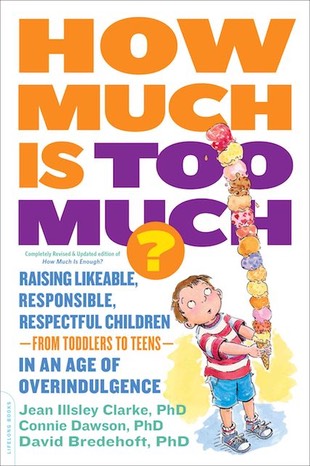Soft Structure vs. Firm Structure?
Let me paint you a picture of both soft and firm structure. The opening birthday party scene in the movie Mrs. Doubtfire comes to mind when I think of soft structure. A petting zoo of barnyard animals running around in and outside of the house as children are bouncing up and down on living room furniture to the tune of Jump Around. The scene ends in a huge fight when Sally Field, who plays Miranda Hillard, comes home to find her husband Daniel Hillard, played by Robin Williams, jumping on the living room furniture with the kids. The final image is that of a donkey eating a birthday cake in the living room; a total mess. Soft structure. No rules. No enforcement of rules. Soft structure is the third type of childhood overindulgence we found in our research.

Source: ambermb/Pixabay
Child development experts believe that to thrive, children need firm structure. Jean Illsley Clarke describes firm structure this way, “Reasonable rules that are consistently enforced, mastery of skills, and learning family values are all part of firm structure. Firm structure not only makes life more secure and predictable for the child; in the long run it also makes life easier for the parents, as many would-be, could-be misadventures and crises are avoided. Maybe best of all, what the child grows up experiencing, she learns to do for herself. Children learn good boundaries and self-care.”
Daniel Hillard transforms himself into Mrs. Doubtfire by disguising himself as an older female housekeeper so he can spend more time with his children. Unlike when he was "dad", Mrs. Doubtfire has rules and expects the children to follow them. She assigns chores and transforms the household by using firm structure. In one of the last scenes in the movie, his children admitted they liked him more when he was firm Mrs. Doubtfire than when he was soft pushover dad.
How Can I Tell If Soft Structure Is My Overindulgence Pattern?
Read and answer the following questions honestly for each child. The more “Yes” answers, the greater the probability that your overindulgence pattern is Soft Structure!
The majority of the time…
- I do not enforce the rules that I make for my child.
- I do not have my child do chores.
- I do not hold my child to consistent standards.
- My child interrupts my conversations with other adults.
- I do things for my child rather than see her/him in distress.
© 2014 by Jean Illsley Clarke, Connie Dawson, and David J. Bredehoft. Used here with permission. No part of this scale may be reproduced by any means, electronic, mechanical, photocopying, or other without permission from the authors.
Soft Structure: What Are The Risks?
Parents are soft on structure for many reasons. Sometimes it is just plain easier. Other times we are tired of being the "bad guy" all of the time. Maybe we want our children to be our “best friends”! All reasons coming from a good heart, but not always helpful for our children in the long run. Our research shows that people who are overindulged with soft structure tended:
- Not to know what is enough
- To have weak social and personal boundaries
- To be trained in irresponsibility
- To have uneven competencies
- To display a lack of gratitude
- To have a false sense of entitlement
- To believe and act as though they are the center of the universe
I Know I’m Soft On Structure - What Do I Do?
As a parent, I know you are concerned about soft structure and you would like to know what to do instead. You may not know who to ask. Here are a few suggestions to help you avoid soft structure and avert the damaging effects of childhood overindulgence.
Read a good book on the subject.
Purchase a hard copy or download a free pdf copy of Good Heart Parenting: A Journey of Love and Strength (2018, University of Minnesota Extension Press).
Read a good article on the subject.
How To Say “NO” to Your Kids — Jean Illsley Clarke discusses the difference between wants and needs and offers thirty-six ways to say no.
44 Ideas to Start Connecting and Stop Overindulging Your Children This Holiday Season — David Bredehoft shares readers’ homegrown ideas on how to curb childhood overindulgence during the holidays.
Take a free online course to learn more about childhood overindulgence.
Developmental Parenting Highway Online Course is a free one-hour online course offered by The University of Minnesota Extension. This course explores a variety of topics including why parenting is like driving on a highway with four helpful lanes, the strengths of each, and help if you slip onto the shoulder or into a ditch.
Do all things with Love, Grace, and Gratitude
© 2019 David J. Bredehoft
References
Bredehoft, D. J., Mennicke, S. A., Potter, A. M., & Clarke, J. I. (1998). Perceptions attributed by adults to parental overindulgence during childhood. Journal of Family and Consumer Sciences Education, 16(2), 3-17.
Clarke, J. I., Dawson, C., & Bredehoft, D. J. (2014). How much is too much? Raising likeable, responsible, respectful children –from toddlers to teens- in an age of overindulgence (pp. 301-302). New York, Da Capo Press.
Clarke, J. I., Dawson, C., & Bredehoft, D. J. (2014). Appendix A: Parental overindulgence assessment tool. In Clarke, J. I., Bredehoft, D. J., & Dawson, C., How much is too much? Raising likeable, responsible, respectful children –from toddlers to teens- in an age of overindulgence (pp. 301-302). New York, Da Capo Press.


